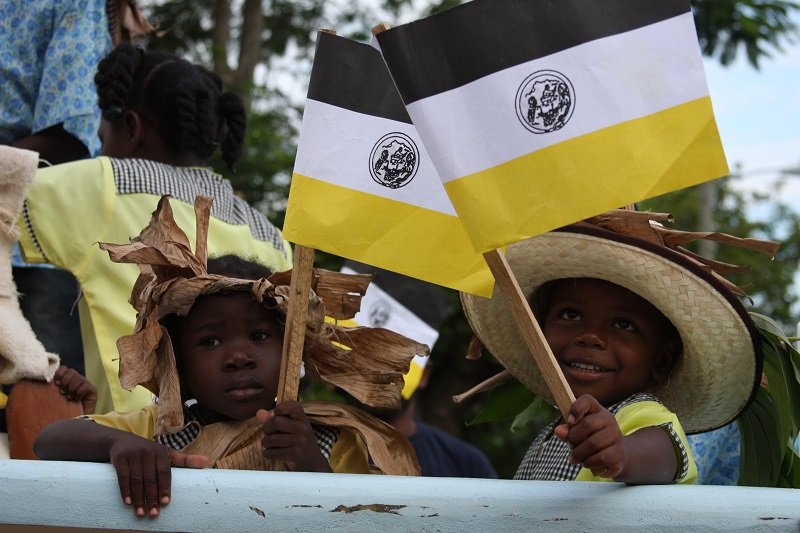Belize Celebrates Garifuna Settlement Day 2014

Mibe La Yanu. Awanse La Wadagimanu. BungiuWaba, WagiaLarigi
This year’s theme: “Let’s not just talk. Let the work progress. God before us and we behind
Garifuna Settlement Day, a national holiday celebrated on the 19th of November each year, is one of the most important days in Belize, and rightfully so.
Commemorating the arrival of the Garifuna, or Garinagu, people on the shores of Belize on that date in 1802, Garifuna Settlement Day reminds us of the struggles, successes, and invaluable contributions of this resilient people and their vibrant culture.
To say that Belize wouldn’t be the same without the Garifuna is an understatement of epic proportions. In education, government, the arts and many other areas, the Garifuna have had a profound impact on the shaping of modern day Belize.
And this year, with the recent passing away of master Garifuna singer/songwriter and national icon Paul Nabor, the celebrations will take on an added poignancy.
But first, some Garifuna history:
The Garifuna saga begins with a fateful shipwreck off the Caribbean island of St Vincent in the 1600s. African slaves, who were being transported aboard the ship when it went down, managed to make it to shore and over time mixed with the indigenous Arawak, or Carib, population.
England won control of St Vincent after the Treaty of Paris in1763, and embarked on a campaign to subdue and control the islanders during what became known as the Carib Wars. After the death of their leader, Joseph Chatoyer, the Caribs finally surrendered to the British in 1796. The British administration then separated the more ethnically African people they called Black Caribs from the Amerindian or Red Caribs and, in 1797, exiled some five thousand Black Caribs to the island of Roatán off the coast of Honduras.
Although less than half of these exiles are said to have survived the journey, they made their way to the mainland and began establishing villages up and down the Central American coast while steadfastly preserving their language and culture. Legend has it that Garifuna women hid cassava in their clothing during the voyage from St Vincent, and the rootstock of those plants, still thriving in gardens today, was essential to the people’s survival. No wonder that cassava is to this day so highly valued for both its nutritional and symbolic role in Garifuna culture.
Originally living in remote, self sustaining villages, the Garifuna eventually became prominent in Belizean society, especially as teachers and serving in the police force and public service. Their unique music, with the Amerindian and African influences and distinctive drumming, echoed throughout Belize and neighbouring countries, evolving into distinctive forms such as Paranda and Punta Rock. In 2001 UNESCO proclaimed the language, dance, and music of the Garifuna as a Masterpiece of the Oral and Intangible Heritage of Humanity in Nicaragua, Honduras, and Belize.
Today the Garifuna make up over 6% of Belize’s population, and a large Belizean Garifuna diaspora thrives in major US cities including New York, Los Angeles and Chicago.
Once again this year, on the morning of November 19th, the Garifuna flag – yellow, white and black to represent the sun, peace and pride in the colour of the Garinagu people, will be raised throughout Belize, and the villages of Barranco, Seine Bight, Dangriga, Hopkins and Punta Gorda will host vibrant celebrations and reenactments of that first landing in dugout canoes.

For Belizeans and visitors alike this is an excellent opportunity to be immersed in Garifuna culture and enjoy some delicious food and lively music and dance.There is always an abundance of traditional Garifuna dishes such as serre, fish boiled in coconut milk and usually served with hudut, the Garifuna staple of mashed plantain.
And, of course, cassava is served in a variety of forms, including traditional cassava bread, which can take several days to make, as well as in various puddings and drinks, including a potent wine.
Throughout the day there will be music, beginning at daybreak when the rhythmic throb of Garifuna drumming begins.
Garifuna music has grown in popularity worldwide in recent years, and is now featured in music festivals around the world and as an essential part of any serious world music collection. The Garifuna Collective recently wound up a highly successful world tour this year with rave reviews and a growing legion of fans. And although two exceptional Garifuna musicians have passed away, the music continues to grow.
Andy Palacio, who suddenly and very sadly left us in 2008, was a brilliant composer and incendiary performer of Punta Rock and other styles, and was invaluable as a Belizean cultural ambassador and Garifuna role model. Paul Nabor, or Nabi to his many friends and fans the world over, passed away on October 22 this year at the age of 86, and up to the end was still playing Paranda, a unique, soulful style sometimes referred to as Garifuna blues. Now the mantle has been passed to a younger generation of musicians such as Aurelio Martinez, who has played to audiences in Carnegie Hall and other prestigious venues around the world. Garifuna musicians can now be found on YouTube as well as on Belize’s main record label, Stonetree Records (www.stonetreerecords.com).
If you’re lucky enough to be in a Garifuna village around the week of November 19th you’re in for a rich cultural treat, and If you can’t be in Belize, why not join the celebrations by getting on the internet and learning about this fascinating culture? We promise you it will be a rewarding experience.
The Garifuna continue to walk the talk, as the saying goes, evolving and adapting to a changing world while maintaining their very special language, culture, music and art, as well as a deep spirituality and connection with their ancestors.
And once again, all of us here at Chaa Creek wish our Garinagu friends, neighbours and family a very Happy Garifuna Settlement Day.